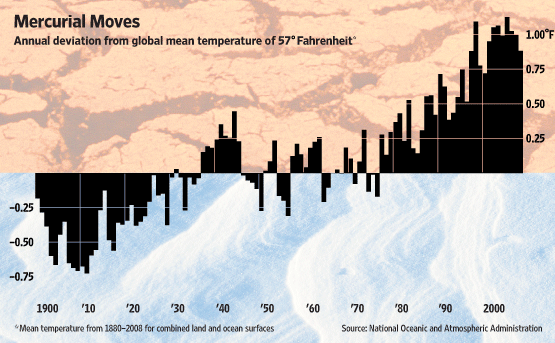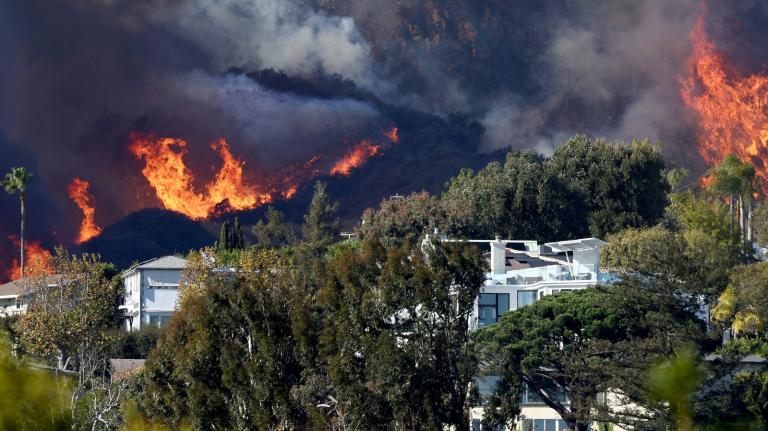Cross-posted from Climate Progress.
Mainstream news outlets spent a lot of time in 2011 covering the record-breaking year for extreme weather in the U.S. But only a few of them spent much time exploring the link between those events and global warming.
So PBS deserves a special mention for a segment that aired last week looking at how global warming is influencing extreme weather events. As Jeff Masters, co-founder of the Weather Underground, explained in the piece: “They all tend to get increased when you have this extra energy in the atmosphere. I call it being on steroids … for the atmosphere.”
Watch the full segment:
And here’s the transcript:
Judy Woodruff: Some of the biggest stories of 2011 involved extreme weather that wreaked havoc in many states and cities. As the year comes to a close, it’s sparking plenty of discussion in the world of science about the causes and meaning of those events.
Hari Sreenivasan explores all that following some background.
Hari Sreenivasan: From snow to floods to tornadoes, it has been a year of record-breaking weather across the U.S. mainland, more, in fact, than any year since modern record-keeping began.
It started in late January with paralyzing blizzards that dumped heavy snow on 22 states. Chicago was buried under nearly two feet of snow, and the Windy City ground to a near standstill.
Raphael Guzman, resident of Chicago: For the past 10 hours, I have traveled 0.9 miles. So, now, when the fire department finally came to see if I wanted to leave my car, I saw the tow truck four cars back, and I was like, I will just wait for it. That was two hours ago.
Man: This is amazing.
HS: Spring brought the start of an especially deadly tornado season, with three of the largest twister outbreaks in American history in just six weeks, killing more than 550 people and causing $25 billion in damage.
More than 300 were killed over three days in late April in Central and Southern states. Tuscaloosa, Ala., was the hardest-hit.
Matt Wilson, resident of Tuscaloosa: It was horrifying. It was coming towards us, so we ran to the back, and got under a metal structure back in the back. And that’s, honestly, what saved us.
HS: Then, in late May, a tornado with winds topping 200 miles an hour leveled the town of Joplin, Mo. It was the single deadliest U.S. tornado since 1947, killing nearly 160 people.
Man: I actually was planning on helping where it was really torn up, but there’s nothing really to help. It’s just flattened. There’s — I don’t know. There’s probably three-quarters of a mile of nothing.
HS: That same storm system brought triple the normal amount of rainfall to the Ohio River Valley. The rain, coupled with snowmelt, caused both the Mississippi and Missouri Rivers to flood.
In August, Hurricane Irene drenched the Eastern Seaboard. It triggered record flooding in New Jersey, New York State, and Vermont, and cost more than $7 billion.
Woman: Once the water started coming through the front door. I mean I knew things were getting bad. And then the walls started to break and the molding started to pop, and I knew I was really in trouble.
HS: The Southern Plains and Southwest could only hope for some of that rain. Texas suffered through its worst one-year drought, as losses reached $10 billion in crops, livestock, and timber.
The tinder-dry conditions in Texas also fueled wildfires that burned a million acres. The Bastrop fire over Labor Day weekend was the state’s most destructive on record. Overall, it was the hottest summer Texas has ever seen. Wichita Falls had more than 100 consecutive days of 100-degree readings.
Nationwide, more than 6,000 heat records have been broken this year. On average, the U.S. has three or four events every year that are considered major natural disasters. But, this year, the National Oceanic and Atmospheric Administration counted at least a dozen such events. Based on reports to date, damages are expected to exceed $52 billion.
Weather around the world showed equal extremes. Australia was hit with record flooding, followed by one of its worst tropical cyclones ever. Floodwaters also ravaged parts of Thailand and China, while the Horn of Africa suffered its worst drought in decades.
We have more on this with two experts who watch the impact of weather closely.
Kathryn Sullivan is the deputy director of NOAA, the National Oceanic and Atmospheric Administration, an oceanographer and former astronaut. She helps oversee NOAA’s work on weather observation and climate sciences. And Jeff Masters, who’s a meteorologist with the Weather Underground website, he joins us from Ann Arbor, Mich.
So thanks for being here.
Ms. Sullivan, I just rattled off what seemed like an exceptional year of weather, but put this in perspective for us. How rare i s this?
Kathryn Sullivan: Well, the prior record-breaking year was nine significant events, well above the three to four that are typical. That was 2008.
So, we went a third again in the number of events each of which had greater than a billion dollars, many other events, of course, that just fell below that billion-dollar threshold through the course of that year, quite a remarkable string, quite a remarkable array.
I came aboard NOAA as the deputy administrator early in May, and the preceding month of April, in one month alone, we had record-breaking flood, wildfire, tornado outbreaks, just all within one single month. It was certainly unprecedented in my experience.
HS: And, Jeff Masters, you’ve said in your blog that you have never seen a year like this. What else stands out to you?
Jeff Masters: In one year, we had three of the most remarkable extreme weather events in history of the U.S.
I mean, we talk about the Dust Bowl summer of 1936. Well, this summer pretty much matched that for temperature, almost the hottest summer in U.S. history. We also talk about the great 1974 tornado outbreak. Well, we had an outbreak that more than doubled the total of tornadoes we had during that iconic outbreak. And, also, we talk about the great 1927 flood on the Mississippi River. Well, the flood heights were even higher than that flood this year.
So, it just boggles my mind that we had three extreme weather events that matched those events in U.S. history.
HS: So, Jeff, how do we tie this in with any particular cause? We can’t say that a temperature warming or a global temperature increase causes a tornado or this hurricane. But what can we say? What does the data show us?
JM: That weather has natural extremes.
We all know that you can have extreme years and not very extreme years. Certainly, this year was a very naturally extreme year. But I argue that when you have a naturally extreme year occurring within the context of global warming, okay, now you’ve put more heat in the atmosphere. That means you have more energy to power stronger storms and more energy also to give you more intense heat waves and droughts.
So, in particular, we look at heat waves, droughts, and flooding events. They all tend to get increased when you have this extra energy in the atmosphere. I call it being on steroids kind of for the atmosphere.
HS: Explain that, being on steroids. What do you mean?
JM: Well, normally, you have the everyday ups and downs of the weather, but if you pack a little bit of extra punch in there, it’s like a baseball hitter who’s on steroids.
You expect to see a big home-run total maybe from this slugger, but if you add a little bit of extra oomph to his swing by putting him on steroids, now we can have an unprecedented season, a 70 home-run season. And that’s the way I look at this year.
We had an unprecedented weather year that I don’t think would have happened unless we had had an extra bit of energy in the atmosphere due to climate change and global warming.
HS: Kathryn, you were in Joplin yourself. What are some of the longer-term impacts, some of the costs that we’re not seeing here as we just total up the dollar signs?
KS: It is a really sobering and heart-wrenching experience to be on the ground in some of those tornado-ravaged areas.
The casualties, of course, the injuries and loss of life take precedence over everything. But the scale — the scale of the damage and the pervasiveness of it really just boggle my mind. The figure I heard that day out in Joplin was there were 1,800 acres of debris. And debris hardly begins to describe it. Things that had been businesses and homes and a large first-class hospital were little more than toothpicks.
Fabulous large trees with trunk diameters up to 18 to 24 inches were maybe 10- or 12-foot-tall stubs with not a shred of bark left on them, just amazing, the power and fury that had ripped through that community in such a really brief period of time.
So, you think about rebuilding a house, but, you know, first to clear some portion of 1,800 acres of debris, it’s just a massive undertaking, then to deal with the administrative mechanics of whatever you might have, insurance and a builder. And for it to be that pervasive over that large of a swathe of a community just means it’s all going to take such a long time to come back.
Small businesses affected, larger, major stores affected with major building damage, firehouses, schools, and then one of the primary hospitals all destroyed. So the fabric of the community is really affected in an experience like this. And that also makes it harder for the community itself and its citizens to rebound, so a very long train of consequences well beyond the media moments that we tend to pay attention to.
HS: Jeff, also, what sorts of economic or geopolitical consequences do you see when we have natural disasters like drought in different parts of the world?
JM: Drought is my No. 1 concern for climate change because drought affects food prices.
We had a terrific drought in Russia last year that caused them to shut off their exports of wheat. Now global food prices spiked thereafter, and it’s thought that the Arab spring revolts that happened this year were due in part to the fact that food prices were so high due to the Russian drought. Those food prices were the highest we have seen since the early 1990s.
Had we had a drought of that magnitude this year in the U.S., there would have been very severe consequences for the global economy, the global food supply, and there would have been a large amount of political unrest, much higher than we saw, I think.
HS: Kathryn, briefly, what kind of changes are you making at NOAA when it comes to modeling, and what are cities trying to do to plan for the possibility of more extreme weather?
KS: Well, we always are working to advance the technology we use to observe the atmosphere in countless ways, as well as the computing infrastructure that runs the forecast models that give us our everyday three-, five-, seven-day outlook.
In addition, this season really has focused our attention even further, along with our partners in the private sector such as Jeff and his colleagues and emergency managers, on the really human part of the warning process. From the forecast information that NOAA puts out for everyone to work with, from there to the signal that triggers someone to take a response, how can we do better on that?
What combination of communication improvements or better understanding how people are accessing information these days, of how people make high-impact decisions, almost the social science side of completing the full warning process certainly will have heightened attention from us in the years ahead.
HS: Alright, Kathryn Sullivan from NOAA, Jeff Masters from Weather Underground, thank you both for being here.
KS: It was a pleasure.



